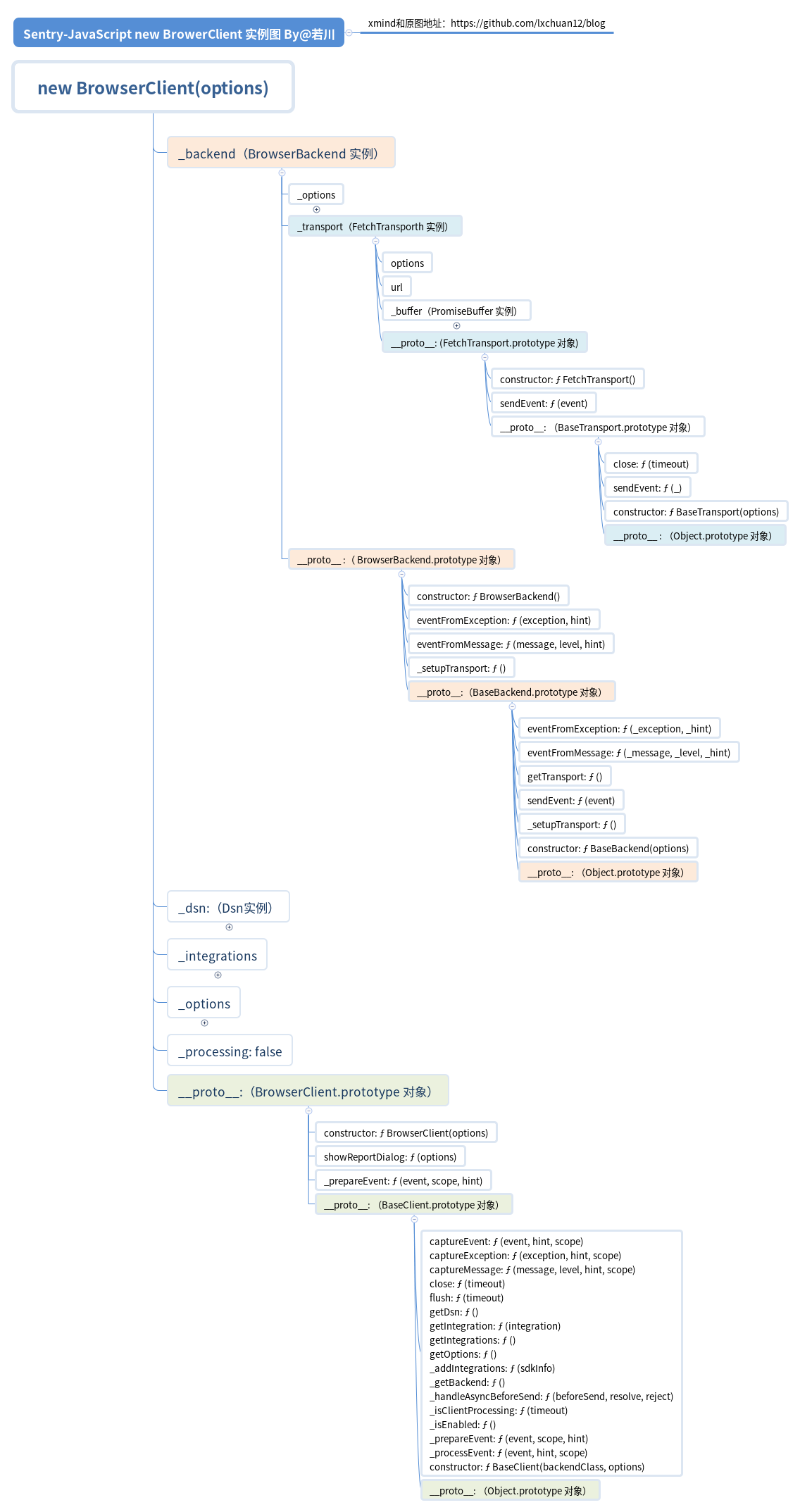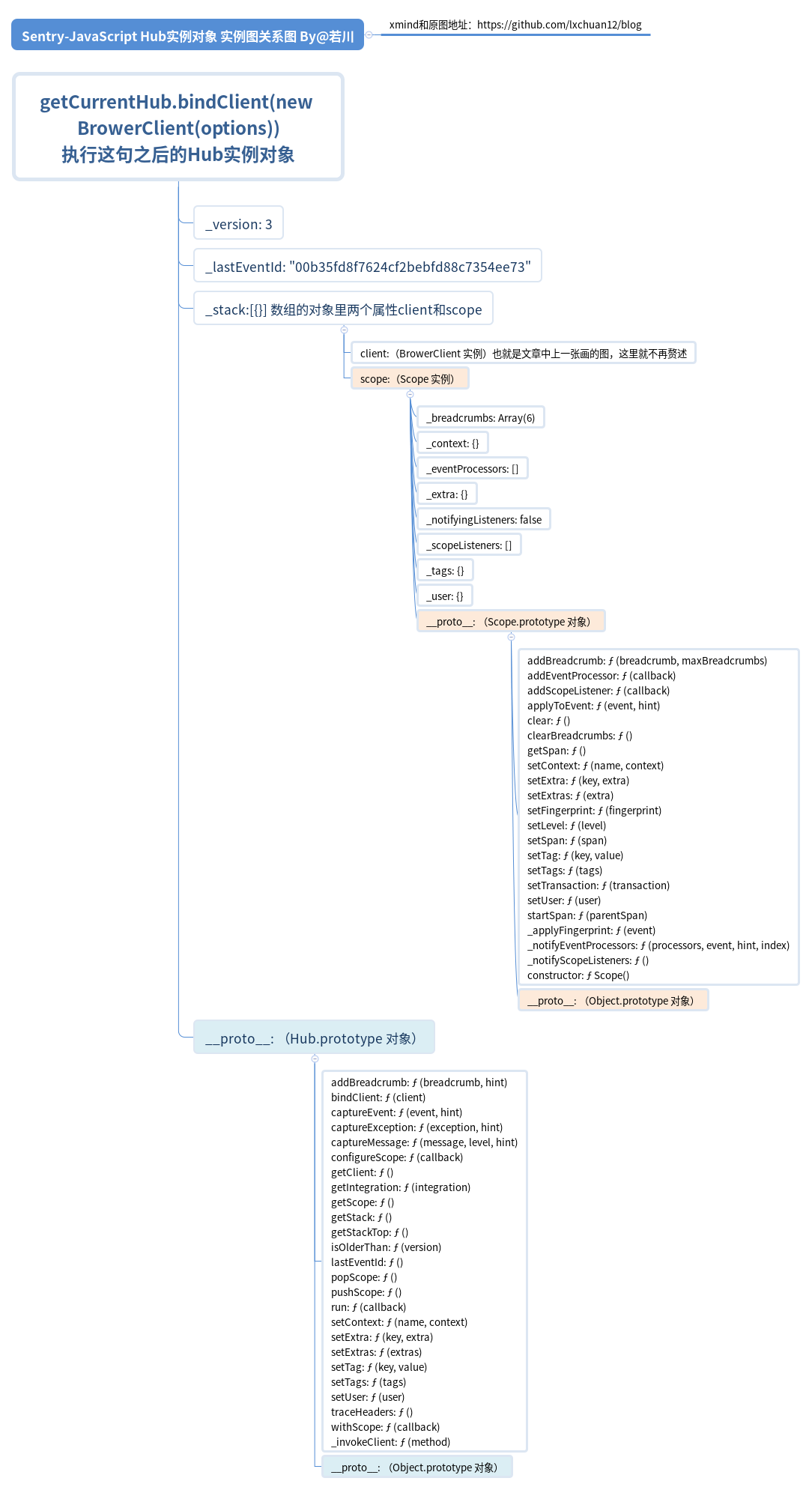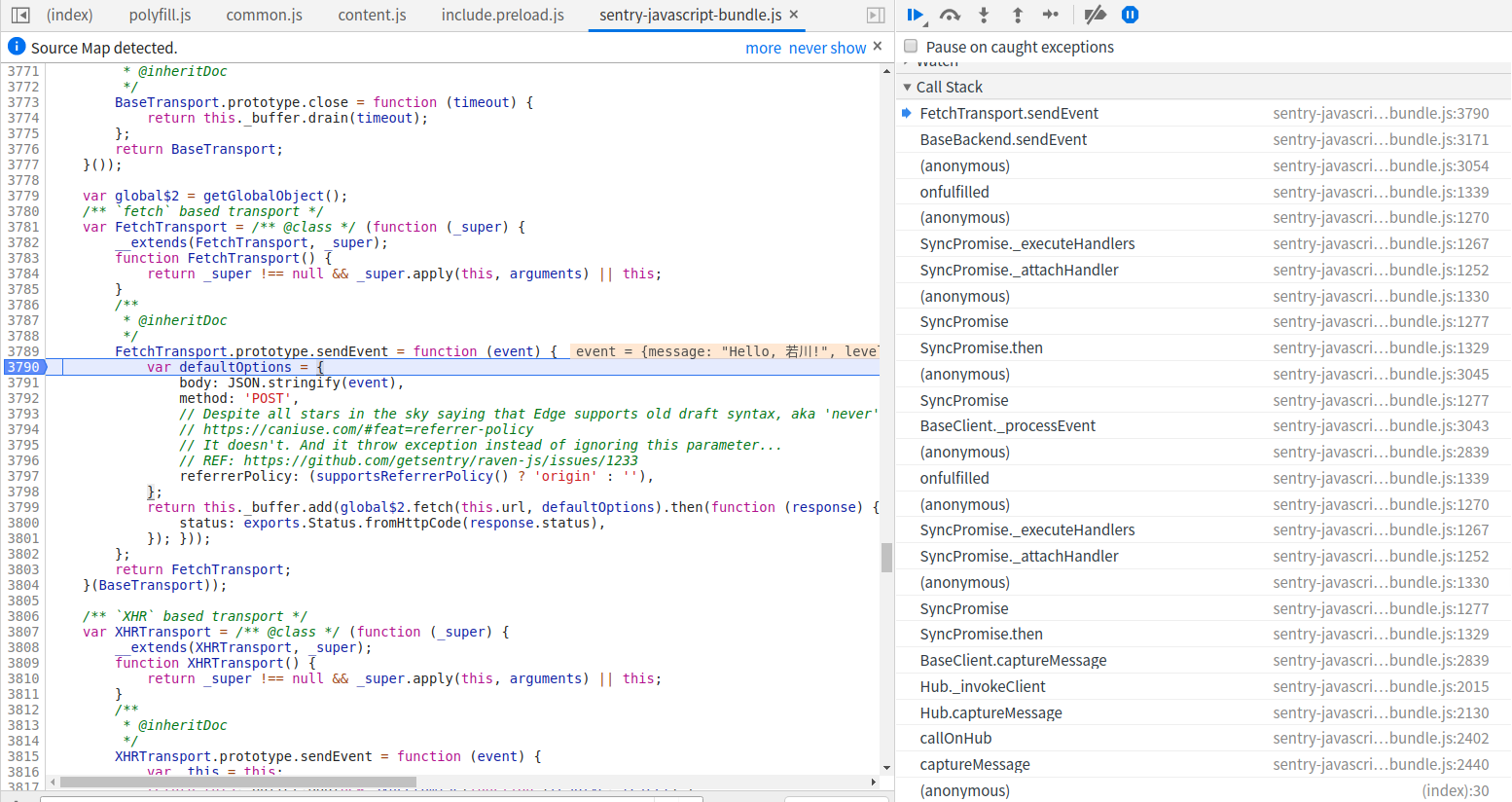# No.5 学习 sentry 源码整体架构,打造属于自己的前端异常监控SDK
# 1. 前言
源码类文章,一般阅读量不高。已经有能力看懂的,自己就看了。不想看,不敢看的就不会去看源码。
所以我的文章,尽量写得让想看源码又不知道怎么看的读者能看懂。
导读
本文通过梳理前端错误监控知识、介绍sentry错误监控原理、sentry初始化、Ajax上报、window.onerror、window.onunhandledrejection几个方面来学习sentry的源码。
开发微信小程序,想着搭建小程序错误监控方案。最近用了丁香园 开源的Sentry 小程序 SDKsentry-miniapp (opens new window)。
顺便研究下sentry-javascript仓库 (opens new window) 的源码整体架构,于是有了这篇文章。
本文分析的是打包后未压缩的源码,源码总行数五千余行,链接地址是:https://browser.sentry-cdn.com/5.7.1/bundle.js (opens new window), 版本是v5.7.1。
本文示例等源代码在这我的github博客中github blog sentry (opens new window),需要的读者可以点击查看,如果觉得不错,可以顺便star一下。
看源码前先来梳理下前端错误监控的知识。
# 2. 前端错误监控知识
摘抄自 慕课网视频教程:前端跳槽面试必备技巧 (opens new window)
别人做的笔记:前端跳槽面试必备技巧-4-4 错误监控类 (opens new window)
# 2.1 前端错误的分类
1.即时运行错误:代码错误
try...catch
window.onerror (也可以用DOM2事件监听)
2.资源加载错误
object.onerror: dom对象的onerror事件
performance.getEntries()
Error事件捕获
3.使用
performance.getEntries()获取网页图片加载错误
var allImgs = document.getElementsByTagName('image')
var loadedImgs = performance.getEntries().filter(i => i.initiatorType === 'img')
最后allIms和loadedImgs对比即可找出图片资源未加载项目
# 2.2 Error事件捕获代码示例
window.addEventListener('error', function(e) {
console.log('捕获', e)
}, true) // 这里只有捕获才能触发事件,冒泡是不能触发
# 2.3 上报错误的基本原理
1.采用Ajax通信的方式上报
2.利用Image对象上报 (主流方式)
Image上报错误方式:
(new Image()).src = 'https://lxchuan12.cn/error?name=若川'
# 3. Sentry 前端异常监控基本原理
1.重写
window.onerror方法、重写window.onunhandledrejection方法
如果不了解onerror和onunhandledrejection方法的读者,可以看相关的MDN文档。这里简要介绍一下:
MDN GlobalEventHandlers.onerror (opens new window)
window.onerror = function (message, source, lineno, colno, error) {
console.log('message, source, lineno, colno, error', message, source, lineno, colno, error);
}
参数:
message:错误信息(字符串)。可用于HTML onerror=""处理程序中的event。
source:发生错误的脚本URL(字符串)
lineno:发生错误的行号(数字)
colno:发生错误的列号(数字)
error:Error对象(对象)
MDN unhandledrejection (opens new window)
当
Promise被reject且没有reject处理器的时候,会触发unhandledrejection事件;这可能发生在window下,但也可能发生在Worker中。 这对于调试回退错误处理非常有用。
Sentry 源码可以搜索 global.onerror 定位到具体位置
GlobalHandlers.prototype._installGlobalOnErrorHandler = function () {
// 代码有删减
// 这里的 this._global 在浏览器中就是 window
this._oldOnErrorHandler = this._global.onerror;
this._global.onerror = function (msg, url, line, column, error) {}
// code ...
}
同样,可以搜索global.onunhandledrejection 定位到具体位置
GlobalHandlers.prototype._installGlobalOnUnhandledRejectionHandler = function () {
// 代码有删减
this._oldOnUnhandledRejectionHandler = this._global.onunhandledrejection;
this._global.onunhandledrejection = function (e) {}
}
2.采用
Ajax上传
支持 fetch 使用 fetch,否则使用 XHR。
BrowserBackend.prototype._setupTransport = function () {
// 代码有删减
if (supportsFetch()) {
return new FetchTransport(transportOptions);
}
return new XHRTransport(transportOptions);
};
2.1
fetch
FetchTransport.prototype.sendEvent = function (event) {
var defaultOptions = {
body: JSON.stringify(event),
method: 'POST',
referrerPolicy: (supportsReferrerPolicy() ? 'origin' : ''),
};
return this._buffer.add(global$2.fetch(this.url, defaultOptions).then(function (response) { return ({
status: exports.Status.fromHttpCode(response.status),
}); }));
};
2.2
XMLHttpRequest
XHRTransport.prototype.sendEvent = function (event) {
var _this = this;
return this._buffer.add(new SyncPromise(function (resolve, reject) {
// 熟悉的 XMLHttpRequest
var request = new XMLHttpRequest();
request.onreadystatechange = function () {
if (request.readyState !== 4) {
return;
}
if (request.status === 200) {
resolve({
status: exports.Status.fromHttpCode(request.status),
});
}
reject(request);
};
request.open('POST', _this.url);
request.send(JSON.stringify(event));
}));
}
接下来主要通过Sentry初始化、如何Ajax上报和window.onerror、window.onunhandledrejection三条主线来学习源码。
如果看到这里,暂时不想关注后面的源码细节,直接看后文小结1和2的两张图。或者可以点赞或收藏这篇文章,后续想看了再看。
# 4. Sentry 源码入口和出口
var Sentry = (function(exports){
// code ...
var SDK_NAME = 'sentry.javascript.browser';
var SDK_VERSION = '5.7.1';
// code ...
// 省略了导出的Sentry的若干个方法和属性
// 只列出了如下几个
exports.SDK_NAME = SDK_NAME;
exports.SDK_VERSION = SDK_VERSION;
// 重点关注 captureMessage
exports.captureMessage = captureMessage;
// 重点关注 init
exports.init = init;
return exports;
}({}));
# 5. Sentry.init 初始化 之 init 函数
初始化
// 这里的dsn,是sentry.io网站会生成的。
Sentry.init({ dsn: 'xxx' });
// options 是 {dsn: '...'}
function init(options) {
// 如果options 是undefined,则赋值为 空对象
if (options === void 0) { options = {}; }
// 如果没传 defaultIntegrations 则赋值默认的
if (options.defaultIntegrations === undefined) {
options.defaultIntegrations = defaultIntegrations;
}
// 初始化语句
if (options.release === undefined) {
var window_1 = getGlobalObject();
// 这是给 sentry-webpack-plugin 插件提供的,webpack插件注入的变量。这里没用这个插件,所以这里不深究。
// This supports the variable that sentry-webpack-plugin injects
if (window_1.SENTRY_RELEASE && window_1.SENTRY_RELEASE.id) {
options.release = window_1.SENTRY_RELEASE.id;
}
}
// 初始化并且绑定
initAndBind(BrowserClient, options);
}
# 5.1 getGlobalObject、inNodeEnv 函数
很多地方用到这个函数getGlobalObject。其实做的事情也比较简单,就是获取全局对象。浏览器中是window。
/**
* 判断是否是node环境
* Checks whether we're in the Node.js or Browser environment
*
* @returns Answer to given question
*/
function isNodeEnv() {
// tslint:disable:strict-type-predicates
return Object.prototype.toString.call(typeof process !== 'undefined' ? process : 0) === '[object process]';
}
var fallbackGlobalObject = {};
/**
* Safely get global scope object
*
* @returns Global scope object
*/
function getGlobalObject() {
return (isNodeEnv()
// 是 node 环境 赋值给 global
? global
: typeof window !== 'undefined'
? window
// 不是 window self 不是undefined 说明是 Web Worker 环境
: typeof self !== 'undefined'
? self
// 都不是,赋值给空对象。
: fallbackGlobalObject);
继续看 initAndBind 函数
# 6. initAndBind 函数之 new BrowserClient(options)
function initAndBind(clientClass, options) {
// 这里没有开启debug模式,logger.enable() 这句不会执行
if (options.debug === true) {
logger.enable();
}
getCurrentHub().bindClient(new clientClass(options));
}
可以看出 initAndBind(),第一个参数是 BrowserClient 构造函数,第二个参数是初始化后的options。
接着先看 构造函数 BrowserClient。
另一条线 getCurrentHub().bindClient() 先不看。
# 6.1 BrowserClient 构造函数
var BrowserClient = /** @class */ (function (_super) {
// `BrowserClient` 继承自`BaseClient`
__extends(BrowserClient, _super);
/**
* Creates a new Browser SDK instance.
*
* @param options Configuration options for this SDK.
*/
function BrowserClient(options) {
if (options === void 0) { options = {}; }
// 把`BrowserBackend`,`options`传参给`BaseClient`调用。
return _super.call(this, BrowserBackend, options) || this;
}
return BrowserClient;
}(BaseClient));
从代码中可以看出:
BrowserClient 继承自BaseClient,并且把BrowserBackend,options传参给BaseClient调用。
先看 BrowserBackend,这里的BaseClient,暂时不看。
看BrowserBackend之前,先提一下继承、继承静态属性和方法。
# 6.2 __extends、extendStatics 打包代码实现的继承
未打包的源码是使用ES6 extends实现的。这是打包后的对ES6的extends的一种实现。
如果对继承还不是很熟悉的读者,可以参考我之前写的文章。面试官问:JS的继承 (opens new window)
// 继承静态方法和属性
var extendStatics = function(d, b) {
// 如果支持 Object.setPrototypeOf 这个函数,直接使用
// 不支持,则使用原型__proto__ 属性,
// 如何还不支持(但有可能__proto__也不支持,毕竟是浏览器特有的方法。)
// 则使用for in 遍历原型链上的属性,从而达到继承的目的。
extendStatics = Object.setPrototypeOf ||
({ __proto__: [] } instanceof Array && function (d, b) { d.__proto__ = b; }) ||
function (d, b) { for (var p in b) if (b.hasOwnProperty(p)) d[p] = b[p]; };
return extendStatics(d, b);
};
function __extends(d, b) {
extendStatics(d, b);
// 申明构造函数__ 并且把 d 赋值给 constructor
function __() { this.constructor = d; }
// (__.prototype = b.prototype, new __()) 这种逗号形式的代码,最终返回是后者,也就是 new __()
// 比如 (typeof null, 1) 返回的是1
// 如果 b === null 用Object.create(b) 创建 ,也就是一个不含原型链等信息的空对象 {}
// 否则使用 new __() 返回
d.prototype = b === null ? Object.create(b) : (__.prototype = b.prototype, new __());
}
不得不说这打包后的代码十分严谨,上面说的我的文章《面试官问:JS的继承》中没有提到不支持__proto__的情况。看来这文章可以进一步严谨修正了。
让我想起Vue源码中对数组检测代理判断是否支持__proto__的判断。
// vuejs 源码:https://github.com/vuejs/vue/blob/dev/dist/vue.js#L526-L527
// can we use __proto__?
var hasProto = '__proto__' in {};
看完打包代码实现的继承,继续看 BrowserBackend 构造函数
# 6.3 BrowserBackend 构造函数 (浏览器后端)
var BrowserBackend = /** @class */ (function (_super) {
__extends(BrowserBackend, _super);
function BrowserBackend() {
return _super !== null && _super.apply(this, arguments) || this;
}
/**
* 设置请求
*/
BrowserBackend.prototype._setupTransport = function () {
if (!this._options.dsn) {
// We return the noop transport here in case there is no Dsn.
// 没有设置dsn,调用BaseBackend.prototype._setupTransport 返回空函数
return _super.prototype._setupTransport.call(this);
}
var transportOptions = __assign({}, this._options.transportOptions, { dsn: this._options.dsn });
if (this._options.transport) {
return new this._options.transport(transportOptions);
}
// 支持Fetch则返回 FetchTransport 实例,否则返回 XHRTransport实例,
// 这两个构造函数具体代码在开头已有提到。
if (supportsFetch()) {
return new FetchTransport(transportOptions);
}
return new XHRTransport(transportOptions);
};
// code ...
return BrowserBackend;
}(BaseBackend));
BrowserBackend 又继承自 BaseBackend。
# 6.3.1 BaseBackend 构造函数 (基础后端)
/**
* This is the base implemention of a Backend.
* @hidden
*/
var BaseBackend = /** @class */ (function () {
/** Creates a new backend instance. */
function BaseBackend(options) {
this._options = options;
if (!this._options.dsn) {
logger.warn('No DSN provided, backend will not do anything.');
}
// 调用设置请求函数
this._transport = this._setupTransport();
}
/**
* Sets up the transport so it can be used later to send requests.
* 设置发送请求空函数
*/
BaseBackend.prototype._setupTransport = function () {
return new NoopTransport();
};
// code ...
BaseBackend.prototype.sendEvent = function (event) {
this._transport.sendEvent(event).then(null, function (reason) {
logger.error("Error while sending event: " + reason);
});
};
BaseBackend.prototype.getTransport = function () {
return this._transport;
};
return BaseBackend;
}());
通过一系列的继承后,回过头来看 BaseClient 构造函数。
# 6.3.2 BaseClient 构造函数(基础客户端)
var BaseClient = /** @class */ (function () {
/**
* Initializes this client instance.
*
* @param backendClass A constructor function to create the backend.
* @param options Options for the client.
*/
function BaseClient(backendClass, options) {
/** Array of used integrations. */
this._integrations = {};
/** Is the client still processing a call? */
this._processing = false;
this._backend = new backendClass(options);
this._options = options;
if (options.dsn) {
this._dsn = new Dsn(options.dsn);
}
if (this._isEnabled()) {
this._integrations = setupIntegrations(this._options);
}
}
// code ...
return BaseClient;
}());
# 6.4 小结1. new BrowerClient 经过一系列的继承和初始化
可以输出下具体new clientClass(options)之后的结果:
function initAndBind(clientClass, options) {
if (options.debug === true) {
logger.enable();
}
var client = new clientClass(options);
console.log('new clientClass(options)', client);
getCurrentHub().bindClient(client);
// 原来的代码
// getCurrentHub().bindClient(new clientClass(options));
}
最终输出得到这样的数据。我画了一张图表示。重点关注的原型链用颜色标注了,其他部分收缩了。

# 7. initAndBind 函数之 getCurrentHub().bindClient()
继续看 initAndBind 的另一条线。
function initAndBind(clientClass, options) {
if (options.debug === true) {
logger.enable();
}
getCurrentHub().bindClient(new clientClass(options));
}
获取当前的控制中心 Hub,再把new BrowserClient() 的实例对象绑定在Hub上。
# 7.1 getCurrentHub 函数
// 获取当前Hub 控制中心
function getCurrentHub() {
// Get main carrier (global for every environment)
var registry = getMainCarrier();
// 如果没有控制中心在载体上,或者它的版本是老版本,就设置新的。
// If there's no hub, or its an old API, assign a new one
if (!hasHubOnCarrier(registry) || getHubFromCarrier(registry).isOlderThan(API_VERSION)) {
setHubOnCarrier(registry, new Hub());
}
// node 才执行
// Prefer domains over global if they are there (applicable only to Node environment)
if (isNodeEnv()) {
return getHubFromActiveDomain(registry);
}
// 返回当前控制中心来自载体上。
// Return hub that lives on a global object
return getHubFromCarrier(registry);
}
# 7.2 衍生的函数 getMainCarrier、getHubFromCarrier
function getMainCarrier() {
// 载体 这里是window
// 通过一系列new BrowerClient() 一系列的初始化
// 挂载在 carrier.__SENTRY__ 已经有了三个属性,globalEventProcessors, hub, logger
var carrier = getGlobalObject();
carrier.__SENTRY__ = carrier.__SENTRY__ || {
hub: undefined,
};
return carrier;
}
// 获取控制中心 hub 从载体上
function getHubFromCarrier(carrier) {
// 已经有了则返回,没有则new Hub
if (carrier && carrier.__SENTRY__ && carrier.__SENTRY__.hub) {
return carrier.__SENTRY__.hub;
}
carrier.__SENTRY__ = carrier.__SENTRY__ || {};
carrier.__SENTRY__.hub = new Hub();
return carrier.__SENTRY__.hub;
}
# 7.3 bindClient 绑定客户端在当前控制中心上
Hub.prototype.bindClient = function (client) {
// 获取最后一个
var top = this.getStackTop();
// 把 new BrowerClient() 实例 绑定到top上
top.client = client;
};
Hub.prototype.getStackTop = function () {
// 获取最后一个
return this._stack[this._stack.length - 1];
};
# 7.4 小结2. 经过一系列的继承和初始化
再回过头来看 initAndBind函数
function initAndBind(clientClass, options) {
if (options.debug === true) {
logger.enable();
}
var client = new clientClass(options);
console.log(client, options, 'client, options');
var currentHub = getCurrentHub();
currentHub.bindClient(client);
console.log('currentHub', currentHub);
// 源代码
// getCurrentHub().bindClient(new clientClass(options));
}
最终会得到这样的Hub实例对象。笔者画了一张图表示,便于查看理解。

初始化完成后,再来看具体例子。
具体 captureMessage 函数的实现。
Sentry.captureMessage('Hello, 若川!');
# 8. captureMessage 函数
通过之前的阅读代码,知道会最终会调用Fetch接口,所以直接断点调试即可,得出如下调用栈。
接下来描述调用栈的主要流程。

调用栈主要流程:
captureMessage
function captureMessage(message, level) {
var syntheticException;
try {
throw new Error(message);
}
catch (exception) {
syntheticException = exception;
}
// 调用 callOnHub 方法
return callOnHub('captureMessage', message, level, {
originalException: message,
syntheticException: syntheticException,
});
}
=> callOnHub
/**
* This calls a function on the current hub.
* @param method function to call on hub.
* @param args to pass to function.
*/
function callOnHub(method) {
// 这里method 传进来的是 'captureMessage'
// 把method除外的其他参数放到args数组中
var args = [];
for (var _i = 1; _i < arguments.length; _i++) {
args[_i - 1] = arguments[_i];
}
// 获取当前控制中心 hub
var hub = getCurrentHub();
// 有这个方法 把args 数组展开,传递给 hub[method] 执行
if (hub && hub[method]) {
// tslint:disable-next-line:no-unsafe-any
return hub[method].apply(hub, __spread(args));
}
throw new Error("No hub defined or " + method + " was not found on the hub, please open a bug report.");
}
=> Hub.prototype.captureMessage
接着看Hub.prototype 上定义的 captureMessage 方法
Hub.prototype.captureMessage = function (message, level, hint) {
var eventId = (this._lastEventId = uuid4());
var finalHint = hint;
// 代码有删减
this._invokeClient('captureMessage', message, level, __assign({}, finalHint, { event_id: eventId }));
return eventId;
};
=> Hub.prototype._invokeClient
/**
* Internal helper function to call a method on the top client if it exists.
*
* @param method The method to call on the client.
* @param args Arguments to pass to the client function.
*/
Hub.prototype._invokeClient = function (method) {
// 同样:这里method 传进来的是 'captureMessage'
// 把method除外的其他参数放到args数组中
var _a;
var args = [];
for (var _i = 1; _i < arguments.length; _i++) {
args[_i - 1] = arguments[_i];
}
var top = this.getStackTop();
// 获取控制中心的 hub,调用客户端也就是new BrowerClient () 实例中继承自 BaseClient 的 captureMessage 方法
// 有这个方法 把args 数组展开,传递给 hub[method] 执行
if (top && top.client && top.client[method]) {
(_a = top.client)[method].apply(_a, __spread(args, [top.scope]));
}
};
=> BaseClient.prototype.captureMessage
BaseClient.prototype.captureMessage = function (message, level, hint, scope) {
var _this = this;
var eventId = hint && hint.event_id;
this._processing = true;
var promisedEvent = isPrimitive(message)
? this._getBackend().eventFromMessage("" + message, level, hint)
: this._getBackend().eventFromException(message, hint);
// 代码有删减
promisedEvent
.then(function (event) { return _this._processEvent(event, hint, scope); })
// 代码有删减
return eventId;
};
最后会调用 _processEvent 也就是
=> BaseClient.prototype._processEvent
这个函数最终会调用
_this._getBackend().sendEvent(finalEvent);
也就是
=> BaseBackend.prototype.sendEvent
BaseBackend.prototype.sendEvent = function (event) {
this._transport.sendEvent(event).then(null, function (reason) {
logger.error("Error while sending event: " + reason);
});
};
=> FetchTransport.prototype.sendEvent 最终发送了请求
# 8.1 FetchTransport.prototype.sendEvent
FetchTransport.prototype.sendEvent = function (event) {
var defaultOptions = {
body: JSON.stringify(event),
method: 'POST',
// Despite all stars in the sky saying that Edge supports old draft syntax, aka 'never', 'always', 'origin' and 'default
// https://caniuse.com/#feat=referrer-policy
// It doesn't. And it throw exception instead of ignoring this parameter...
// REF: https://github.com/getsentry/raven-js/issues/1233
referrerPolicy: (supportsReferrerPolicy() ? 'origin' : ''),
};
// global$2.fetch(this.url, defaultOptions) 使用fetch发送请求
return this._buffer.add(global$2.fetch(this.url, defaultOptions).then(function (response) { return ({
status: exports.Status.fromHttpCode(response.status),
}); }));
};
看完 Ajax 上报 主线,再看本文的另外一条主线 window.onerror 捕获。
# 9. window.onerror 和 window.onunhandledrejection 捕获 错误
例子:调用一个未申明的变量。
func();
Promise 不捕获错误
new Promise(() => {
fun();
})
.then(res => {
console.log('then');
})
# 9.1 captureEvent
调用栈主要流程:
window.onerror
GlobalHandlers.prototype._installGlobalOnErrorHandler = function () {
if (this._onErrorHandlerInstalled) {
return;
}
var self = this; // tslint:disable-line:no-this-assignment
// 浏览器中这里的 this._global. 就是window
this._oldOnErrorHandler = this._global.onerror;
this._global.onerror = function (msg, url, line, column, error) {
var currentHub = getCurrentHub();
// 代码有删减
currentHub.captureEvent(event, {
originalException: error,
});
if (self._oldOnErrorHandler) {
return self._oldOnErrorHandler.apply(this, arguments);
}
return false;
};
this._onErrorHandlerInstalled = true;
};
window.onunhandledrejection
GlobalHandlers.prototype._installGlobalOnUnhandledRejectionHandler = function () {
if (this._onUnhandledRejectionHandlerInstalled) {
return;
}
var self = this; // tslint:disable-line:no-this-assignment
this._oldOnUnhandledRejectionHandler = this._global.onunhandledrejection;
this._global.onunhandledrejection = function (e) {
// 代码有删减
var currentHub = getCurrentHub();
currentHub.captureEvent(event, {
originalException: error,
});
if (self._oldOnUnhandledRejectionHandler) {
return self._oldOnUnhandledRejectionHandler.apply(this, arguments);
}
return false;
};
this._onUnhandledRejectionHandlerInstalled = true;
};
共同点:都会调用currentHub.captureEvent
currentHub.captureEvent(event, {
originalException: error,
});
=> Hub.prototype.captureEvent
最终又是调用 _invokeClient ,调用流程跟 captureMessage 类似,这里就不再赘述。
this._invokeClient('captureEvent')
=> Hub.prototype._invokeClient
=> BaseClient.prototype.captureEvent
=> BaseClient.prototype._processEvent
=> BaseBackend.prototype.sendEvent
=> FetchTransport.prototype.sendEvent
最终同样是调用了这个函数发送了请求。
可谓是殊途同归,行文至此就基本已经结束,最后总结一下。
# 10. 总结
Sentry-JavaScript源码高效利用了JS的原型链机制。可谓是惊艳,值得学习。
本文通过梳理前端错误监控知识、介绍sentry错误监控原理、sentry初始化、Ajax上报、window.onerror、window.onunhandledrejection几个方面来学习sentry的源码。还有很多细节和构造函数没有分析。
总共的构造函数(类)有25个,提到的主要有9个,分别是:Hub、BaseClient、BaseBackend、BaseTransport、FetchTransport、XHRTransport、BrowserBackend、BrowserClient、GlobalHandlers。
其他没有提到的分别是 SentryError、Logger、Memo、SyncPromise、PromiseBuffer、Span、Scope、Dsn、API、NoopTransport、FunctionToString、InboundFilters、TryCatch、Breadcrumbs、LinkedErrors、UserAgent。
这些构造函数(类)中还有很多值得学习,比如同步的Promise(SyncPromise)。
有兴趣的读者,可以看这一块官方仓库中采用typescript写的源码SyncPromise (opens new window),也可以看打包后出来未压缩的代码。
读源码比较耗费时间,写文章记录下来更加费时间(比如写这篇文章跨度十几天...),但收获一般都比较大。
如果读者发现有不妥或可改善之处,再或者哪里没写明白的地方,欢迎评论指出。另外觉得写得不错,对您有些许帮助,可以点赞、评论、转发分享,也是对笔者的一种支持。万分感谢。